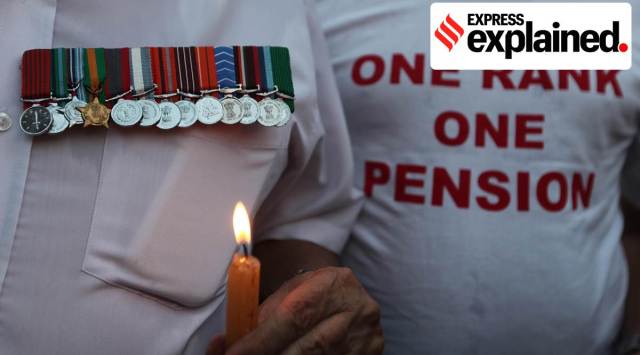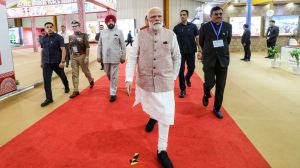Explained: The rank-pension case
The Supreme Court has upheld the govt scheme for one rank, one pension (OROP). What was the history of the retired service personnel’s demand, and on what grounds was the govt proposal challenged?
 Protest in Chandigarh in August 2015. OROP was notified in November that year. (File)
Protest in Chandigarh in August 2015. OROP was notified in November that year. (File)The Supreme Court on Wednesday ruled there was “no constitutional infirmity” in the way the government had introduced ‘one rank, one pension’ (OROP) among ex-service personnel. The scheme, notified by the Defence Ministry on November 7, 2015, was challenged by Indian Ex-Service Movement, an association of retired defence personnel.
🗞️ Subscribe Now: Get Express Premium to access the best Election reporting and analysis 🗞️
One rank, one pension
OROP means that any two military personnel retiring at the same rank, with the same years of service, must get an equal pension. While this might appear almost obvious, there are several reasons why two military personnel who may have retired at the same rank with the same years of service, may get different pensions.
Military personnel across the three services fall under two categories, the officers and the other ranks, as they’re called. The other ranks, which are soldiers, usually retire at age 35. Unlike government employees who retire close to 60, soldiers can thus miss out on the benefits from subsequent pay commissions. And since pensions are based on the last drawn salary, pensions too are impacted adversely.
Similarly, the age when officers in the military retire depends upon their ranks. The lower the rank, the earlier they superannuate.
But the problem is not just that.
From 1950 to 1973, there was a concept known as the Standard Rate of Pension, which was similar to OROP. In 1974, when the 3rd Pay Commission came into force, certain changes were effected in terms of weightage, additional years of notion service, etc., with regard to pensions. In 1986, the 4th Pay Commission’s report brought further changes.
What ultimately happened was that the benefits of the successive pay commissions were not passed to servicemen who had retired earlier. Pensions differed for those who had retired at the same rank, with the same years of service, but years apart.
Demand for OROP
Ex-servicemen demanded OROP to correct the discrepancy. Over the decades, several committees looked into it. The Brig K P Singh Deo committee in 1983 recommended a system similar to Standard Rate of Pension, as did Parliament’s standing committees on defence. The Narendra Modi government notified the current OROP scheme in November 2015, and it was made applicable from July 1, 2014.
There are several reasons why soldiers have to retire early, the main reason being that the country needs a young military. It was argued that early retirement should not become an adverse element for what a soldier earns as pension, compared with those who retire later.
Question of finance
During the OROP protests of 2013-15, it was argued repeatedly that meeting the demand would be financially unsustainable. Because soldiers retire early and remain eligible for pension for much longer than other employees, the Defence Ministry’s pension budget is very large, which impacts its capital expenditure.
The Parliament Standing Committee on Defence report submitted on Wednesday says there were 26,79,645 armed forces pensioners in the country as of April 1, 2021.
The total defence pensioners are 32.9 lakh, but that includes 6.14 lakh defence civilian pensioners.
The actual expenditure of the Defence Ministry on pensions was Rs 1.18 lakh crore in 2019-2020, Rs 1.28 lakh crore in 2020-2021, and Rs 94,860 crore until January 2022 for the current financial year.
The Defence Ministry’s pension-to-budget ratio is the highest among all ministries, and pensions are more than one-fifth of the total defence budget. Retired defence personnel also have the largest share in pensions among all retired government employees.
There are administrative and legal issues involved too. When the late Manohar Parrikar was Defence Minister, it was estimated that a one-time payout of Rs 83,000 crore would be needed to clear all past issues. However, every time a new pay commission came, it would lead to substantial payouts to bring parity.
Challenge to OROP
The petitioners contended that the principle of OROP had been replaced by ‘one rank multiple pensions’ for persons with the same length of service. They submitted that the government had altered the initial definition of OROP and, instead of an automatic revision of the rates of pension — under which any future raising of pension rates would be passed on to past pensioners — the revision would now take place at periodic intervals. According to the petitioners, this was arbitrary and unconstitutional under Articles 14 and 21.
The demand for OROP was initially examined by Parliament in 2010-11. In its report of December 2011, the Rajya Sabha Committee on Petitions (Koshyari Committee) recommended the implementation of OROP. The panel defined OROP as a uniform pension to be paid to armed forces personnel retiring in the same rank with the same length of service, irrespective of their date of retirement.
In February 2014, the UPA government announced it had accepted OROP in principle, and that it would be implemented prospectively from 2014-15. In December 2014, the NDA government in a reply to Parliament reaffirmed the principle of automatic revision.
The court noted that the petitioners had highlighted this sequence of events to show that OROP always entailed an automatic revision. However, the petitioners contended, the government’s letter of November 7, 2015 introduced a revised definition of OROP, where the revision between the past and current rates was to take place at periodic intervals.
The court’s ruling
The court did not agree with the argument that the government’s 2015 policy communication contradicted the original decision to implement OROP. It said that “while a decision to implement OROP was taken in principle, the modalities for implementation were yet to be chalked out”, and that “there was no conscious policy decision on the part of the Union Government on the modalities for implementing OROP until the communication dated 7 November 2015 came into being”.
The court also said that while the Koshyari Committee report furnishes the historical background of the demand, and its own view on it, it “cannot be construed as embodying a statement of governmental policy”.
The court said that the OROP policy “may only be challenged on the ground that it is manifestly arbitrary or capricious”. After evaluating the government’s policy, it found “no constitutional infirmity in the OROP principle as defined by the communication dated 7 November 2015”.
Newsletter | Click to get the day’s best explainers in your inbox





- 01
- 02
- 03
- 04
- 05


































